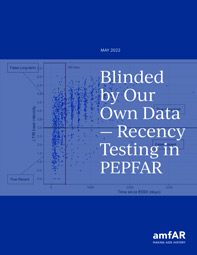Blinded By Our Own Data
PEPFAR (the U.S. President’s Emergency Plan for AIDS Relief) began introducing an HIV recency test-based surveillance system in 2019 that’s now partially implemented in at least 24 countries, with a large scale-up of these programs expected in 2022 and 2023. The goal of recency surveillance for PEPFAR is to identify and respond to new transmissions in small geographic areas and sub-populations as quickly as possible to halt any further transmission and better target HIV prevention and testing resources.
HIV recency tests were developed to indicate simply whether an individual “recently” acquired the virus. For years, these tests have been useful to estimate HIV incidence in populations broadly—at national and sub-national regional levels, according to age and sex. But is recency testing the right approach for what PEPFAR’s “hot-spot” surveillance hopes to accomplish?

A new report by amfAR’s Public Policy Office, Blinded by Own Own Data—Recency Testing in PEPFAR, says no.
While understanding PEPFAR’s commitment to focus testing resources toward areas and populations with the highest transmission rates, the report outlines how recency-based testing is limited:
- It fails to diagnose individuals with true recent infections (infected less than six months) between 35% and 68% of the time;
- recency testing alone in the field returns false positive results between 15% and 90% of the time as being on treatment, having advanced HIV disease, and other factors can affect the accuracy of the test;
- the inter-reliability of recency testing is suspect;
- routine program data are likely to bias results in unpredictable ways; and
- recency testing doesn’t provide real-time information.
The approach also raises ethical and human rights concerns and requires substantial financial and human resources that come directly at the cost of core HIV service delivery, say the report’s authors.
Ultimately, the report concludes that a recency-based surveillance system cannot overcome its limitations to provide actionable data to identify real and potential HIV “hot spots” and does not warrant PEPFAR’s nor ministries of health’s re-allocation of already-limited resources.
The report makes recommendations for PEPFAR to reevaluate the programmatic utility of this approach and provide increased transparency for the system’s roll-out.
amfAR is committed to providing data-driven resources that help community- and country-based advocates navigate programs such as PEPFAR that provide vital resources to people living with and at risk for HIV.
Read the full report here.
Share This:
